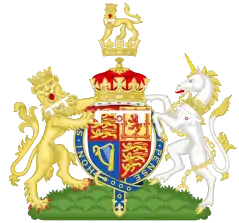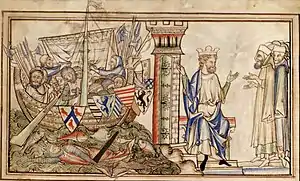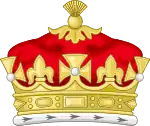Earl of Wessex
Earl of Wessex is a title that has been created three times in British history, twice in the pre-Conquest Anglo-Saxon nobility of England and once in the Peerage of the United Kingdom. The region of Wessex (the ‘West Saxons’), in the south and southwest of England, had been one of the Anglo-Saxon kingdoms (the Heptarchy), whose expansion in the tenth century created a united Kingdom of England.
| Earldom of Wessex | |
|---|---|
 | |
| Creation date | 19 June 1999[1] |
| Creation | Third |
| Monarch | Queen Elizabeth II |
| Peerage | Peerage of the United Kingdom |
| Present holder | The Prince Edward |
| Heir apparent | James, Viscount Severn |
| Remainder to | the 1st Earl's heirs male of the body lawfully begotten |
| Subsidiary titles | Earl of Forfar (title of The Earl of Wessex when in Scotland) Viscount Severn[2] |
| Seat(s) | Bagshot Park |
First and second creations (11th century)
Wessex was one of the four earldoms of Anglo-Danish England.[3] In this period, the earldom of Wessex covered the lands of the old kingdom of Wessex, covering the counties of the south of England, and extending west to the Welsh border.
During the reign of King Cnut, the earldom was conferred on Godwin at some time after 1020.[4] Thereafter, Godwin rose to become, in King Edward's time, the most powerful man in the kingdom. Upon Godwin's death in 1053, the earldom passed to his son, who later became King Harold II and died at the Battle of Hastings in 1066.
Following the Norman conquest in the winter of 1066, King William bestowed the earldom on William FitzOsbern, his most trusted companion.[5] FitzOsbern continued to help William consolidate his new realm until his death in Flanders in 1071. Following this, the earldom was reduced in power and regional jurisdiction, and it passed to FitzOsbern's son, Roger, as the earldom of Hereford.[6]
First creation, c. 1019
| Earl | Portrait | Birth | Marriages | Death |
|---|---|---|---|---|
| Godwin, Earl of Wessex House of Godwin also: Earl of Wessex (1019); Earl of Kent (1020) |
 |
Born probably in Sussex, Godwin's father was probably Wulfnoth Cild, who was a thegn of Sussex |
Gytha Thorkelsdóttir c. 997 11 children |
15 April 1053 Winchester, Hampshire, England Age unknown |
| Harold Godwinson House of Godwin also: Earl of East Anglia (1052); Earl of Wessex (1053); King of England (1066) |
.jpg.webp) |
c. 1022 Son of Godwin of Wessex and Gytha Thorkelsdóttir |
(1) Edith Swannesha 5 children (2) Ealdgyth c. 1064 2 sons |
14 October 1066 Hastings Died in the Battle of Hastings aged 44 |
| Upon Godwin's death, the earldom passed to his son, who later became King Harold II and died at the Battle of Hastings in 1066; the title became extinct on his death. | ||||
Second creation, c. 1066
| Earl | Portrait | Birth | Marriages | Death |
|---|---|---|---|---|
| William FitzOsbern also: Earl of Wessex (1066); Earl of Hereford (1067) |
c. 1020 son of Osbern the Steward |
(1) Adeliza de Tosny 3 children (2) Richilde, Countess of Mons and Hainaut c. 1070 1 child |
22 February 1071 Flanders aged 50-51 | |
| FitzOsbern was created Earl of Wessex, a title which his son did not inherit; the title became extinct on his death. | ||||
Third creation (1999)
In 1999, Queen Elizabeth II's youngest son, Prince Edward, married Sophie Rhys-Jones. Younger sons of the monarch have customarily been given dukedoms at the time of their marriage, and experts had suggested the former royal dukedoms of Cambridge and Sussex as the most likely to be granted to Prince Edward. Instead, the Palace announced that Prince Edward would eventually be given the title Duke of Edinburgh, which is currently held by his father. This is unlikely to happen by direct inheritance, as Prince Edward is the youngest of Prince Philip's three sons. Rather, the title is expected to be newly created for Prince Edward after it "eventually reverts to the crown"[7] after "both the death of the current Duke of Edinburgh and the Prince of Wales' succession as King."[8]
In the meantime, in keeping with the tradition of a monarch's son receiving a title upon marriage, but preserving the rank of duke for the future, Prince Edward became the first British prince in centuries to be specifically created an earl, rather than a duke. His wife Sophie became The Countess of Wessex. The Sunday Telegraph newspaper reported that he was drawn to the historic title of Earl of Wessex after watching the 1998 film Shakespeare in Love, in which a character with the title 'Lord Wessex' is played by Colin Firth.[9]
The current Earl of Wessex is also Viscount Severn.[10] This subsidiary title is used as a courtesy title by the Earl's son and heir to his title, James, who was born on 17 December 2007.
| Earl | Portrait | Birth | Marriages | Death |
|---|---|---|---|---|
| Prince Edward House of Windsor 1999–present also: Earl of Forfar (2019), Viscount Severn (1999) |
 |
10 March 1964 Buckingham Palace, London son of Queen Elizabeth II and Prince Philip |
19 June 1999 Sophie Rhys-Jones 2 children |
– now 56 years, 328 days old |
Line of succession
 Prince Edward, Earl of Wessex (b. 1964)
Prince Edward, Earl of Wessex (b. 1964)
- (1) James, Viscount Severn (b. 2007)
Notes
- "No. 55536". The London Gazette. 28 June 1999. p. 7011.
- "No. 55536". The London Gazette. 28 June 1999. p. 7011.
- Anglo-Saxon Chronicle, 1007: "In this year also was Edric appointed alderman over all the kingdom of the Mercians.", 1017: "This year also was Alderman Edric slain at London".
- Mason p33
- The Normans: The History of a Dynasty, by David Crouch p100
- The Normans: The History of a Dynasty, by David Crouch p108
- "The Earl of Wessex". Royal.gov.uk. Archived from the original on 3 December 2010. Retrieved 2010-10-30.
- Whitaker's Almanack 2010, page 46 'Peers of the Blood Royal'
- Richard Eden (12 December 2010). "Royal wedding: Prince William asks the Queen not to make him a duke". The Telegraph. Retrieved 12 December 2010.
- "No. 55536". The London Gazette. 28 June 1999. p. 7011.
References
- David Crouch, The Normans (2002) ISBN 1-85285-387-5
- Emma Mason The House of Godwine (2004) ISBN 1-85285-389-1
